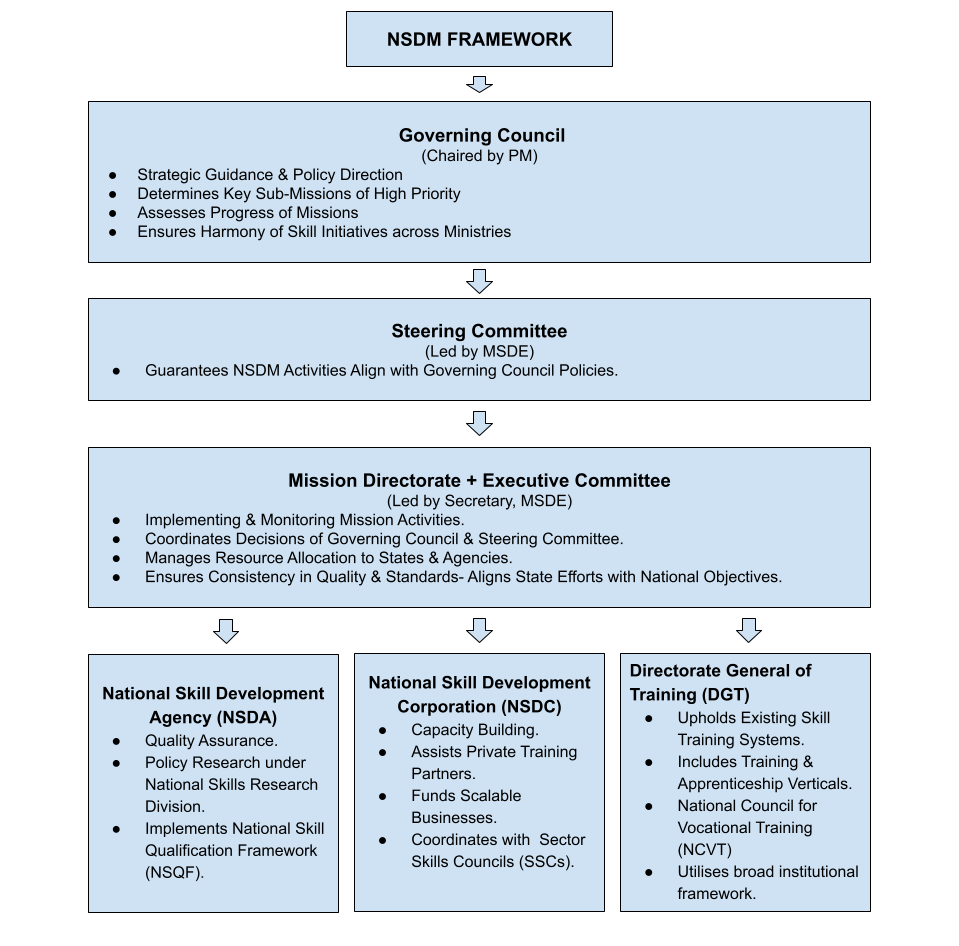Introduction
With a young population, India has a demographic dividend advantage that it must utilise to fulfil its ‘Viksit Bharat 2047’ vision. This demographic advantage stems from a large working-age population in comparison to dependents, creating a favorable environment for rapid economic growth. To tap into this potential, it is essential to convert this demographic edge into a productive and engaged workforce. The Labour Force Participation Rate (LFPR), which measures the proportion of the working-age population actively employed or seeking employment, and the Worker Population Ratio (WPR), which indicates the percentage of people employed among the population, serve as important indicators in this context. The latest Periodic Labour Force Survey (PLFS) Report 2023-24 revealed the LFPR for people over the age of 15 was 60.1%, showcasing a consistent rise, from 57.9% in 2022-23 and 55.2% in 2021-22. The WPR also witnessed a rise with 58.2% people over the age of 15 employed as compared to 56% in 2022-23 and 52.9% in 2021-22.
However, as the LFPR and WPR are surging, so is the workforce’s dependence on agriculture. The PLFS report reveals that 46.1% of the workforce is employed in agriculture, unveiling an increased dependence on agriculture as compared to 45.8% of 2022-23 and 45.5% of 2021-22. On the other hand, employment shares in the industrial and services sectors witnessed a decline, with manufacturing reducing to 11.4% and services decreasing to 29.7%. There is a need to reduce this dependence on agriculture to facilitate structural changes in the economy. As reflected in the Economic Survey 2023-24, the Indian economy must generate an average of 78.5 lakh non-farm jobs each year until 2030 to adequately engage its rising workforce.
PLFS reports that only 50.2% of the workforce has secondary level or above education. Additionally, only 4.1% of people aged 15-59 years have received formal training and 30.6% have received training other than formal training, of which 7.1% are self-taught and 9.3% learnt on the job. A significant portion of 65.3% have not received any vocational or technical training. Per the Economic Survey 2024-25, the outcome of this educational-skill composition is that on one hand, 88.2% of the workforce is employed in low-competency jobs, and on the other hand, over 53% of graduates and 36% of postgraduates are underemployed in jobs below their qualifications. This highlights the need for providing formal training to upskill the workforce as well as reduce underemployment. Moreover, India Skills Report (ISR) 2025 reveals the employability rate of 54.81% for Indian graduates. While this rate is an improvement from the 48.2% reported in 2019, it also highlights the need to evaluate the formal education system and restructure it to align with the labor market requirements.
With the motive of harnessing the potential of the nation’s demographic dividend by further improving employability through skilling, upskilling, and reskilling individuals, the Government launched The Ministry of Skill Development & Entrepreneurship (MSDE) in 2014. MSDE has been allocated a sum of Rs. 6,100 crores in the Budget 2025-26, showcasing a substantial increase from the previously allotted Rs. 4520 crores in 2024-25, Rs. 3517 crores in 2023-24, and Rs. 2999 crores in 2022-23.
National Skill Development Mission
Skills—defined as any marketable expertise however acquired, irrespective of whether marketed or not, or whether the intention in acquiring it was to market it or not— came rather late on the Indian agenda with the 11th Year Plan, which formulated the Skill Development Policy that was superseded in 2015 by the National Skill Development Mission in 2015 under the aegis of the MSDE. The NSDM was initiated with the goal of skilling at least 30 crore people by 2022, with a comprehensive governance framework stretching from the centre to the districts, covering a host of occupational and skill categories and with a significant involvement of the private sector. On the one hand, it compared the dismal performance of formal skilling landscape in India vis-a-vis other economies such as the UK, USA, Japan & South Korea—setting itself with a high benchmark to achieve; and on the other hand, it intended the mission to increase gainful employment, international quality standards, formalization of the economy, enable pathways between vocational and formal education systems, and support weaker and disadvantaged sections of the society in social mobility.

Initiatives to Skill India
Pradhan Mantri Kaushal Vikas Yojana (PMKVY)
Launched in 2015, PMKVY began as a pilot initiative aimed at fostering skill development through free short-term training and financial rewards for certification. Due to the success of the pilot scheme, PMKVY 2.0 was launched for the period 2016-2020, with the objective of training 1 crore youth and an allocated budget of Rs. 12,000 crores. In January 2021, PMKVY 3.0 was introduced, building upon earlier phases and focusing on the establishment of District Skill Committees (DSCs) to tackle skill shortages at the district level. PMKVY 4.0 was announced in the Union Budget 2023-24, with a focus on artificial intelligence, robotics, mechatronics, and drones. The achievements of PMKVY, as on 31st March 2024, can be found in the table below.
| Scheme | Enrolled Candidates | Trained Candidates | Certified Candidates | Placed Candidates | Placement Rate (in %) | Placement Trend (in %) |
| PMKVY 1.0 | 19,86,016 | 19,86,016 | 14,51,636 | 2,53,296 | 12.7% | – |
| PMKVY 2.0 | 1,06,13,955 | 1,10,00,708 | 91,57,547 | 21,41,575 | 19.46% | + 6.76% |
| PMKVY 3.0 | 6,31,972 | 7,37,502 | 5,08,360 | 43,016 | 5.8% | – 13.6% |
| PMKVY 4.0 | 23,61,798 | 5,43,636 | 2,55,902 | 2,042 | 0.37% | – 5.4% |
(Source: MSDE Annual Report 2023-24)
The scheme is structured into two main components: the Centrally Sponsored Centrally Managed (CSCM), which is overseen by NSDC, and the Centrally Sponsored State Managed (CSSM), which is implemented by SSDM in various States and Union Territories. Skills are imparted in the form of Short Term Training (STT), Recognition of Prior Learning (RPL) program, and Special Projects (SP). STT offers 200-500 hours of skill training at PMKVY-affiliated centres for dropouts or unemployed individuals. RPL provides certification after a 12-80 hour orientation for existing skills. SP delivers need-based, flexible training in NSQC-approved roles, particularly for remote areas with challenging compliance requirements.
Key features of PMKVY 4.0 include customised courses up to 210 hours, Short-Term Training (STT) by Skill Hubs (colleges, schools, government institutions), and industry-demand-based skill courses mapped to district Skill Development Plans. Special Projects focus on sectors like agriculture, handicraft, and high-end courses. Skill India Digital Hub serves as the central platform for enrolment and managing the training cycle. The scheme also promotes collaboration between vocational and educational streams, expanding the network of training providers through partnerships with educational institutions.
| Scheme | RPL | STT | SP | Total |
| PMKVY 1.0 | 100.00% | 100.00% | NA | 100.00% |
| PMKVY 2.0 | 97.91% | 92.77% | 91.95% | 95.79% |
| PMKVY 3.0 | 99.17% | 86.94% | 94.66% | 91.79% |
| PMKVY 4.0 | 40.84% | 19.02% | 33.36% | 23.02% |
Percentage of candidates trained under the CSCM component of PMKVY
| Scheme | RPL | STT | SP | Total |
| PMKVY 2.0 | NA | 95.65% | 98.62% | 95.68% |
| PMKVY 3.0 | 98.19% | 94.50% | 96.72% | 96.58% |
Percentage of candidates trained under the CSSM component of PMKVY
The above tables display the percentage of candidates trained under PMKVY over the course of its four phases as per the MSDE Annual Report 2023-24. The data suggests a decline in enrollments, calculated on the basis of those who have been trained relative to the total number of enrollments, after PMKVY 1.0 under both the CSCM and CSSM components, reducing from 100% to 23.02% by PMKVY 4.0. This decreasing trend in completion of training as compared to enrollments hints at the increasing dropout rates prevalent in the scheme.
The top five sectors under which candidates are enrolled in PMKVY 4.0 are Electronics and Hardware (20.2% candidates enrolled), IT-ITeS (11.58% candidates enrolled), Apparel (9.18% candidates enrolled), Handicrafts and Carpet (7.7% candidates enrolled), and Beauty and Wellness (6.03% candidates enrolled). Additionally, the top job roles under which candidates are enrolled in PMKVY 4.0 are Traditional Hand Embroider (4.97% candidates enrolled), Sewing Machine Operator (2.98% candidates enrolled), Domestic Data Entry Operator (2.56% candidates enrolled), Electric Vehicle Service Technician (1.81% candidates enrolled), and Associate Data Entry Operator (1.68% candidates enrolled).
National Apprenticeship Promotion Scheme (NAPS)
MSDE commenced NAPS in 2016 to provide financial support to establishments that conduct apprenticeship programs under the Apprenticeship Act, 1961. The scheme aims to develop a skilled workforce by promotion of on-the-job experiential training. The scheme was extended to continue as NAPS-2 from 2022-23. In 2018, a national portal was introduced for the scheme. This portal acts as the primary platform for overseeing apprenticeship training under NAPS and facilitates comprehensive management of the entire apprenticeship life cycle.
The Direct Benefit Transfer (DBT) was introduced by the Government of India on April 21, 2022, under the NAPS 2.0. This initiative allows for the direct transfer of 25% of the stipend, with a limit of Rs. 1,500 per month for each apprentice, into their Aadhaar-linked accounts. As on 7th September 2024, a total of 36.6 lakh apprentices have been engaged, 18.5 lakh have completed training, and 5.6 lakh apprentices have been certified. Additionally, Rs. 395 crore has been disbursed as stipend through DBT. The dominant sectors in which the apprentices are engaged are automotive sector (6.9 lakh), information technology (3.7 lakh), electronics (3.1 lakh), retail (3 lakh), and production and manufacturing (2.2 lakh).
A point to be noted is that in a workforce of 56.5 crore, a miniscule fraction of 2% is engaged as apprentices. The dropout rate has also been rising, rising from less than 1% in FY 2018-19 to 35% in FY 2024-25. These figures highlight a concern regarding the scheme’s outreach and efficiency.
PM Vishwakarma
The scheme was launched in 2023, with the aim to improve the quality and accessibility of products and services offered by artisans and craftspeople, facilitating their integration into both domestic and international value chains. It offers comprehensive support to assist them in progressing within their trades, thereby enhancing their socio-economic conditions and overall quality of life. This scheme will be implemented collaboratively by MSME, MSDE, and Department of Financial Services under the Ministry of Finance, with an initial rollout planned till 2027-28.
The beneficiaries receive formal recognition through a PM Vishwakarma certificate and an identity card, validating their expertise. The scheme offers skill upgradation through both basic and advanced training programs, during which participants are provided a daily stipend of ₹500 to support their learning process. Artisans benefit from a toolkit incentive of ₹15,000, allowing them to purchase essential tools for their craft. The scheme also enables access to collateral-free loans for enterprise development, offering up to Rs. 3 lakh in two installments—Rs. 1 lakh initially and Rs. 2 lakh subsequently—at a reduced interest rate of 5%, thus fostering entrepreneurial development. Additionally, the scheme provides comprehensive marketing assistance, including support for quality certification, branding, and promotion, enabling artisans to expand their market reach and enhance their income opportunities. The scheme covers 18 trades- Carpenter, Boat Maker, Armorer, Blacksmith, Hammer and Tool Kit Maker, Locksmith, Goldsmith, Potter, Sculptor, Cobbler, Mason, Basket/Mat/Broom Maker/Coir Weaver, Doll & Toy Maker, Barber, Garland maker, Washermen, Tailor, and Fishnet maker.
As on 7th June 2024, 12.33 lakh beneficiaries have registered under the scheme, 3.82 lakh have completed basic training, 6.2 lakh individuals have been certified. Over 30,000 loan applications have been sanctioned and 1,196 loans disbursed. The financial outlay for the scheme from 2023-24 to 2027-28 is Rs. 13,000 crore. Though details about stipend disbursement have not been provided, as the reply to Lok Sabha question, Minister of MSME Sushri Shobha Karandlaje detailed that loans worth of Rs. 3,168 crore have been sanctioned under the scheme as on 17th March 2025.
Jan Shikshan Sansthan (JSS)
The scheme supports marginalised and disadvantaged groups by providing customised skill training for self or wage employment. The target beneficiaries are individuals aged 15-45, including non-literate and school dropouts up to the 12th standard. The scheme focuses upon women, scheduled castes, scheduled tribes, minorities, disabled and other backward sections of the society. The scheme was initially launched in 1967 as Shramik Vidyapeeth, with the aim of providing training through NGOs. The scheme was transferred from the
Ministry of Education to MSDE on 2nd July 2018.
Under this scheme, the JSS provides financial assistance in the form of Grants in-aid for the provision of technical training to target beneficiaries. The Ministry’s aim is to set up JSS in a phased manner in each region of the country. Priority is given to aspirational districts, backward districts, LWE-affected districts, hilly/island areas and border areas across States/UTs. Per the 43rd Report of the Standing Committee on Labour, Textiles and Skill Development (17th Lok Sabha) on ‘Demands for Grants (2023-24)’ of the MSDE, the industry aims to set up 551 JSSs by 2025-26 and increase the training capacity from 5.4 lakh to 9.91 lakh. The Ministry also notified that during a period of three years from 2020 to 2023, 9 JSS have been shut down due to poor performance and administrative problems.
According to the 3rd Report of the Standing Committee on Labour, Textiles and Skill Development (18th Lok Sabha) on Demands for Grants (2024-25) of the MSDE, the aim was to train 7,49,700 trainees in 2024-25. As of 10th October 2024, 2,35,744 trainees have been enrolled. However, the data on employment is not provided under the achievements of JSS – it stops short at the number of certified candidates.
The Case of Automotive Sector
The rising demand from the beneficiaries of PMKVY and NAPS necessitates the need to assess the progress of skill development missions in the automotive sector—especially as it stands to benefit significantly from increased budget allocation for 2025-26 and Industry 4.0, which integrates connectivity, artificial intelligence (AI), automation, and advanced manufacturing technologies. Furthermore, recent ISR findings reveal that the manufacturing and automotive sectors are spearheading the recruitment of new talent, hence creating a demand for skilled workforce in the sector.
The automotive industry comprises Original Equipment Manufacturers (OEM), Auto components and after-sales market. According to the Automotive Skill Development Council (ASDC) Annual Report 2023-2024, the Indian automotive market is experiencing notable growth. The Automotive Mission Plan (AMP) 2016–26 predicts that the sector would contribute 12% to the GDP and comprise 40% manufacturing GDP, while also contributing 13% excise duty. The sector is intended to grow 3.5 times in output and could have the potential to export 35-40% total output. AMP 2016-26 underscores the importance of skilling for the sector’s development. An ASDC-EY report projects industry employment to rise from the current 3.2 crore to 4.5 crore by 2026. This increase would be due to higher labour elasticity. With advancement in automation and industry 4.0, there is growing potential for horizontal mobility, as skilling components from other capital-intensive industries—such as electronics, hardware, and IT/ITeS—can be absorbed by the sector. This transferability of skills is also relevant for customer-facing services, particularly in the after-sales segment.
A NSDC-KPMG report revealed that the rise in the deployment of IT-supported automotive systems, such as global positioning systems (GPS), anti-lock braking systems (ABS), automatic speech recognition (ASR), and safety technologies, is encouraging innovation in the automotive components sector, leading to a greater demand for skilled personnel. The emergence of automation and Industry 4.0 technologies requires a shift towards advanced and knowledge-driven skill sets. The report also suggests that shortage of skilled workforce is affecting the quality and productivity in the sector. It emphasises that skill development is particularly necessary in research and development, design, manufacturing, drivers, sales and marketing, and after-sales. A NITI Aayog report expounds on the skill shortage by reporting that the workers current skill sets are more aligned with traditional internal combustion engine (ICE) vehicle production rather than electric powertrains, battery management, software integration, and AI-driven manufacturing.
Per the reports, while a variety of private engineering colleges are available, the availability of diploma and ITI programs is still restricted and heavily dependent on government institutions. However, they often exhibit ineffective operations and fail to produce job-ready graduates. Additionally, their curriculum tends to be outdated and misaligned with the latest technological advancements in the industry. The institutes are yet to completely align their curricula with the evolving technologies.
The KPMG report also reveals concerning labour trends. There has been an increase in labour conflicts, particularly among Maruti, Honda, and Toyota. The conflicts stem from the dire working conditions faced by the workers. Safe in India’s Annual Report on safety in India’s automotive sector reveals thousands of workers lose their fingers in the automotive sector. Trends suggest over 75% of total injuries are crush injuries, wherein workers lose their fingers. Majority injuries are sustained by low-paid and unskilled machine operators. Factories continue to under-report injuries and safety checks have been reducing over time. As posited by Professor Nagaraj in an article, the reason for these unsafe working conditions could be the scrapping of mandatory safety regulations by the Government for boosting India’s Ease of Doing Business (EDB) rank.
Moving forward, it is crucial to skill and re-skill the workforce for the sector development. As propounded by the ASDC report, the existing workforce needs to be re-skilled across all levels to adapt to new technologies. This can be done by training programmes organised within the companies or by collaborating with ASDC. The jobs requiring major re-skilling are sales consultant, service technicians, mechanical and electrical maintenance, welders, assemblers, etc. There is also a pressing need to promote entry-level jobs in tier-3 and tier-4 auto component manufacturers, since most students aim for jobs with large Original Equipment Manufacturers (OEMs), tier-1 and tier-2 auto component manufacturers, and prominent vehicle dealerships. This can be facilitated by focussing on skilling of workforce and and promotion of Small and Medium enterprises (SMEs).
The government, recognising the strategic importance of the sector, has introduced several initiatives under Automotive Mission Plan (AMP) 2016–26, which envisions the sector growing nearly fourfold by FY26 to 6.6 crore units. The Ministry of Heavy Industries launched the Production Linked Incentive (PLI) Scheme for Automobile and Auto Components, through which, ASDC has established advanced skill qualifications that align with Level 6 of the NSQF, supported by the Ministry’s Capital Goods Promotion Scheme II. Per ASDC Annual Report, there are trained individuals in 153 automotive job roles, concentrating on sectors such as robotics, automation, smart manufacturing, Industry 4.0, electric vehicles, alternative fuels, and sustainability.
NAPS also plays a key role in skilling the workforce in the automotive industry. During the FY 2023-24, ASDC nearly doubled its apprenticeship contracts, reaching 1.9 lakh from 1.02 lakh the previous year, with substantial backing from 114 organizations, mainly component manufacturers. ASDC is now targeting 2.50 lakh contracts for the fiscal year 2024–25.
Conclusion
A skilled workforce is crucial for economic development, staying ahead of the transforming trends, and stimulating job creation. To fully leverage India’s current demographic advantage, it is crucial to prioritise skill development. The National Skill Development Mission is an important step towards skill development in the country. While the mission has laid the groundwork for a more organised skilling ecosystem, it is still in its early phases and is evolving to meet industry requirements and global trends. It is of utmost importance that the mission focuses on developing high-quality skill building programmes that are inclusive and future-oriented.
Only by investing in skilling, re-skilling, and upskilling programmes, India would be able to bridge the skill gap and secure its position as an economic leader in the global forum. The advancement of automation, artificial intelligence, and innovative industries calls for a workforce that is proficient in relevant skills. Without prompt reforms, India risks a widening skill gap that could slow down the economic growth and curtail opportunities for many.






